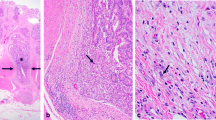Abstract
Background: Colonic tattooing with india ink is a widely practiced technique regarded as safe, accurate, and reliable. In this series, the largest reported, the safety of this technique is studied.
Methods: A retrospective study of 8,125 consecutive patients who undersent colonoscopy over a 64-month period was conducted. India ink colonic mucosal tattooing was used for either preoperative marking or future endoscopic identification of a lesion.
Results: During the study, 195 patients underwent endoscopic injection of india ink. Of these, 50 patients were marked before surgery, and 145 underwent marking with the intent of facilitating future endoscopic localization. Patients were followed by either telephone interviews or physical examination. None of the patients developed fever, persistent abdominal pain, or abdominal tenderness on examination. All surgeons were interviewed. They uniformly reported the tattoo as intensely visible and of great utility in locating the lesions.
Conclusions: Preoperative mucosal tattooing with india ink is recommended as a safe and necessary procedure.
Similar content being viewed by others
Author information
Authors and Affiliations
Additional information
Received: 31 March 1998/Accepted: 1 August 1998
Rights and permissions
About this article
Cite this article
McArthur, C., Roayaie, S. & Waye, J. Safety of preoperation endoscopic tattoo with india ink for identification of colonic lesions. Surg Endosc 13, 397–400 (1999). https://doi.org/10.1007/s004649900997
Published:
Issue Date:
DOI: https://doi.org/10.1007/s004649900997




